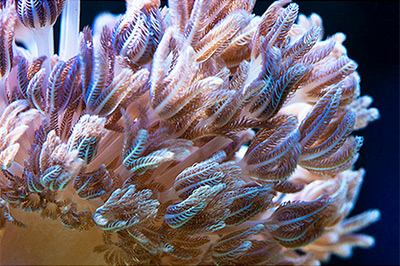In discussions of coral placement in reef aquaria, topics such as spacing between colonies, distance from the light source, level of water flow, sweeper tentacles, and coral chemical warfare (allelopathy) often predominate. But there are special considerations beyond these that one must take into account when determining the best placement for certain soft corals and polyps. Here are just a few examples:
Major tissue expansion and contraction
With many of the SPS corals, the difference in the size of a colony between its expanded and contracted state tends to be fairly negligible. On the other hand, with certain soft corals, such as Sinularia, Lobophytum, and Sarcophyton leather corals, this difference can be quite dramatic, with colonies in their fully expanded state easily doubling or tripling their size when contracted. The degree of a colony’s expansion can vary not just based on daytime/nighttime, but also the system’s lighting, water flow, water quality, and other factors.
If you don’t take this into consideration when placing a new colony in your system, a neighboring colony that has plenty of “elbow room” (corals have elbows, right?) today might be overshadowed tomorrow.
The cascade effect
Some soft corals have a nice compact tree-like growth habit when they’re relatively small, but as they grow, they tend to become more loose and top-heavy and then ultimately lie over, oftentimes cascading down the rockwork (depending on where they’re situated, of course). This can pose a problem for colonies situated downhill from them. Capnella spp. corals—commonly called Kenya tree corals—come to mind here.
Colony wanderlust
You may want that colony of pulsing Xenia to stay right where you put it, but it likely has other ideas. When I introduced this species to my 75-gallon reef tank (no longer in operation), I bought a rock with four or five polyps on it and placed it in an open space in the rockwork toward the back of my tank. It was the perfect placement from the standpoint of visual appeal. But apparently pulse corals don’t share my aesthetic sensibilities because the polyps soon abandoned the rock altogether and worked their way up the back pane of the aquarium, where they reproduced to an obscene level.
Of course, if I knew then what I know now—that pulse corals can move fairly quickly to areas with more favorable conditions and seem to prefer growing in a vertical orientation—none of this would have surprised me.
Compulsive encrustation
I’ve written frequently on the tendency for certain soft corals and polyps to encrust every available surface, but it bears repeating here. The biggest offenders are species that spread rapidly via mats or runners of tissue, such as green star polyps and colonial zoanthids.
To prevent these prolific polyps from getting out of hand, it’s best to situate the rock/plug/rubble they’re attached to away from any other rockwork or surfaces you don’t want them to grow on and/or to prune away any growth that is extending where it’s not welcome. Just be advised that relying on the latter measure is risky because encrusting colonies can get away from you pretty quickly.



